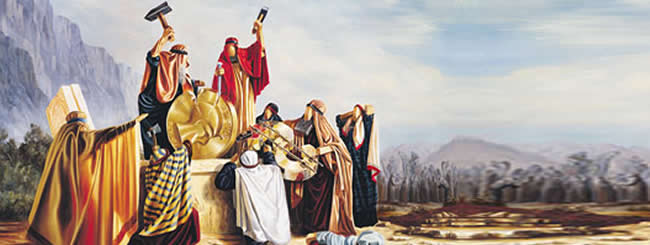
SAN DIEGO — How’s your hearing lately? Are you listening?
Ha’azinu is one of the seven songs in Tanakh and is one of the shortest parshiot in the Torah with just 52 verses, filled with a treasure of information and striking imagery. It is written in two narrow columns. This is the last parasha of the Torah that is read on Shabbos. Rabbi Yaakov Wolbe tells us, “In its 613 words, it incorporates all of Torah… it is arguably the most difficult Torah portion to decipher and unpack.” The song of Ha’azinu beautifully encapsulates the purpose and history of our people, and gracefully elucidates the duties, the advantages, and the outcomes of being the nation assigned Hashem’s mission.
This week’s parasha begins with “Listen, O heavens, and I will speak! And let the earth hear the words of my mouth!”
הַאֲזִינוּ הַשָּׁמַיִם וַאֲדַבֵּרָה וְתִשְׁמַע הָאָרֶץ אִמְרֵי־פִי
The Torah portion we read this week focuses on the theme of personal accountability and responsibility for our behaviors to help us live in this animalistic world, with Hashem. We are urged to be accountable for our choices. “If it is to be, it is up to me”:
Give ear, O heavens, let me speak;
Let the earth hear the words I utter!
We heard the Shofar, we say the Shema “Hear O Israel…,” we hear a d’var Torah, but do we listen?
You see, hearing is a passive sensory experience, simply perceiving noise, vibrations, jangle, echo. Listening is an active choice of paying attention, assigning meaning to what we hear, necessary to promote and advance our learning. Ha’azinu differs from sh’ma, the verb familiar from the Shema we say daily. Where sh’ma means to hear, ha’azinu points to a more empowered listening, an experience that requires intentional effort and purposeful persistence.
Rashi tells us that seeing, similarly, can be understood to involve passive sight, seeing what is in front of us, while vision is the gift of seeing possibility, with deep understanding, clarity and empathy.
It seems that language – verbal and non-verbal – matter. We’ve just come through Rosh Hashanah and Yom Kippur, days filled with stirring words.
It is our responsibility to gain something meaningful in the words we hear. Was the shofar just noise, or did you make something meaningful, perhaps filling you with remorse and hope, from the blasts? Hearing, in all its subtly, is how you choose to respond to the sounds you hear around you, and around the world. This parasha might be considered an audiologist’s marketing dream. When one truly hears, it means she/he makes an effort and takes time to reflect, mindfully, purposefully, on what was heard.
We have ability to imbue our lives with holiness, and to do so requires that we use the gifts of vision and listening, not just seeing and hearing.
As we build, decorate and dwell in our Sukkot, as we wave the arba minim, the Four Species, the Lulav and Etrog, what will we envision, what will we listen to around us that can elevate our experience? Will we grow through, or will we merely go through, the motions? Sure, words can be more precious than gold, but only if we listen to those words and only if our vision allows us to truly see gold in words.
Ha’azinu tells us there is always a song that we can sing if we will listen and use the depth of vision to see that. Long after the Shofar has stilled, we can continue to listen to, not merely hear, its alarm to awaken and remain visionary.
Moshe offers us a very moving, powerfully inspirational cry from his heart, a quite dramatic moment in history in his song – his last gift to us, to help us grasp the core values he wants us to understand, to live by, and to continue to pass along to future generations, to ensure we understand what the core principles are of what it means to be a Jew. Moshe urges us to listen to and hear his wise counsel for the last time before we move forward into the Promised Land, without him.
The “song” of Ha’azinu teaches us about how the Jewish people have abandoned the Torah. Do we really want to sing about this? Yes. Ha’azinu is divided into three sections, the first dealing with the kindness of Hashem. The second section deals with our sinning, forgetting our relationship with Hashem, and the consequences of doing so. The third section is about our return to Hashem. You see, when we listen to the depth of this song, we learn what the Ramban reveals to us – the song is really about our never-ending relationship with Hashem. Despite all our suffering throughout history, despite what may seem like his rejection of us due to our rejection of Him, nevertheless He loves us deeply and our relationship with Him endures. He does what it takes to continually remind us of our relationship with Him. Ha’azinu is a song of a relationship that continues forever. And we hear this powerful shirah four times, teaching us further that commitment without chazarah (review) is empty. Studying the shirah repetitively, four times, shows us the importance of continually reviewing our own attributes and our dedication to Torah learning.
Are we listening, deepening our relationship, can we bring our vision to see what could be when we take Moshe’s heartfelt cry to us and live by his words, or are we dulled and stultified, with a deaf ear and a closed mind, for example simply hearing the din of the Torah reader, merely seeing activity on the bima in our synagogue? When we hear, we engage our mind. When we listen, we engage our heart. To feel truly inspired, we need both. This is the essence of “emotional intelligence.”
To deepen this quality, we might consider following the thoughts of Rav Avigdor Miller, a leading baalei mussar in America, who was noted for his clarity and simplicity of how to grow closer to Hashem. Smile at others, think about how Hashem created them in His image, say “I love you Hashem” once a day. Start with something small. It will grow. In the inspiring words of “What a Wonderful World,” which asks us to see, really see,
The colors of the rainbow
So pretty in the sky
Are also on the faces
Of people going by
I see friends shaking hands
Saying, “How do you do?”
They’re really saying
“I love you””
After all, only days since the end of our most solemn holy day, Yom Kippur, we find ourselves preparing for our most joyous holiday, Sukkot. This is the only time we are truly commanded to be happy, v’samachta b’chagecha, “You shall rejoice in your festival.”
We have ability to imbue our lives with holiness and joy, and to do so requires that we use the gifts of vision and listening, not just seeing and hearing. See beyond the outside…see the goodness on the inside:
I see trees of green
Red roses too
I see them bloom
For me and you
And I think to myself
What a wonderful world
The Tanya, Rabbi Shneur Zalman of Liadi, points out that the inspiration of Moses is within every Jew. Closeness to heaven is thus within the reach of each of us. Indeed, our time is rich in the potential for increasing our holiness, and our closeness to Hashem. When we open ourselves to the possibility of a closer relationship with Him, and with each other, our lives benefit by becoming what our prophets have been singing about throughout all time.
Of course, we cannot control every adversity in life. But with the right mindset, the right attachment to Hashem, Ha’azinu reminds us that things can always be turned around for the better. That’s what this season of t’shuvah has been about…to remind us that the choices we make every moment can be a force for good.
*
Michael R. Mantell, Ph.D., prepares a weekly D’var Torah for Young Israel of San Diego, where he and his family are members. They are also active members of Congregation Adat Yeshurun. He may be contacted via michael.mantell@sdjewishworld.com



























Shalom, Boqer tov, tenho utilizado essas ricas informações em minhas leituras das Parashiot semanais, enriquece o nosso aprendizado. Que o Eterno Abençoe.